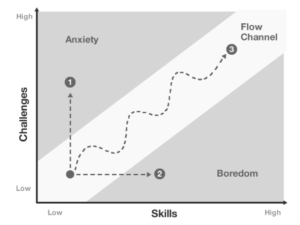In business and in life, we are either growing or dying. There is no in between.
Unfortunately many corporate environments suck the soul out of us. They drain our energy, fail to provide the challenge and growth we all seek, and don’t provide an environment where people can move toward their highest potential and have a greater impact on this world. It’s not surprising that the Gartner Group cites that 77% of employees are disengaged or that 70% of people do not feel considered at work.
It doesn’t have to be that way.
When we create a work environment that fosters growth and provides a platform to positively impact the world, we tap into the core human workplace needs which lead to true fulfillment.
The 6 Human Workplace Needs
In my last 4 posts, I’ve shared our new model called The 6 Human Workplace Needs. It’s intent is to provide a pathway toward creating a healthy, aligned and more human workplace.
The first 4 needs are what we call the Core Needs – needs that all people seek at a fundamental level at work.
- Connection with people
- Certainty as a result of safety
- Contributions are valued
- Clarity of the what and how
The last 2 needs are the Fulfillment Needs – needs that result in meaningful and purpose-driven work.
- Challenge and growth
- Community impact
Let’s explore the first Fulfillment Need of Challenge and Growth.
What is Challenge and Growth?
In a recent coaching conversation, I could hear the tension in my client’s voice. The job was easy and he enjoyed the work/life balance, but he wasn’t done yet. He wasn’t ready to wind down his career and be satisfied with the easy road ahead. Throughout his career he’d felt challenged in his role in public policy. Even though his current role came with the important responsibilities of managing day-to-day operations at a small start-up, it didn’t provide him with the challenge and growth he needed to find true fulfillment in his work.
According to the book Flow, The Psychology of Optimal Experience, enjoyable events occur when a person has not only met some prior expectation or satisfied a need or a desire but also gone beyond what he or she has been programmed to do and achieved something unexpected, perhaps something even unimagined before.
For my client, even though the work conditions all met his core human workplace needs of connection, certainty, contributions being valued and clarity, there was something missing. He wasn’t evolving as a human being.
He was bored.
How to Create Challenge and Growth
As leaders, we need to ask ourselves how we can help people meet their higher level needs at work. How do we create the right conditions for them to feel challenged by their work and a sense that they growing?
To do so, leaders have to think about their mindset, skillset and daily habits. Let’s start with mindset.
1. Mindset
The mindset shift for most leaders is to see people development as a critical part of their role.
 It’s helpful to understand that the balance is one between providing too much challenge where a team member becomes overwhelmed and anxious and not enough challenge where the team member becomes bored and stagnant. The mindset a leader needs to obtain is one where they realize that people have different needs – not just based on personality type – but also on competence and individual career goals. As the image from Flow above shows, when goals are too aggressive, it’s natural for team members feel anxious and overwhelmed. When goals are not challenging, it’s easy for people to experience boredom and restlessness.
It’s helpful to understand that the balance is one between providing too much challenge where a team member becomes overwhelmed and anxious and not enough challenge where the team member becomes bored and stagnant. The mindset a leader needs to obtain is one where they realize that people have different needs – not just based on personality type – but also on competence and individual career goals. As the image from Flow above shows, when goals are too aggressive, it’s natural for team members feel anxious and overwhelmed. When goals are not challenging, it’s easy for people to experience boredom and restlessness.
Both conditions lead team members away from the optimal experience and further from a sense of health and well-being.
2. Skillset
Leaders need 3 key skills to help team members on the optimal path toward challenge and growth.
First, they need the ability to have career enhancing conversations with people to understand what’s important to them, how they want to progress, and the opportunities that exist both within and outside of the organization.
Second, they need the situational leadership skills to match their leadership approach to the competence and confidence level of their people – finding the flow between anxiety and boredom.
Third, they need the ability to set clear expectations and provide the feedback and feedforward so that team members experience the right level of support without feeling micromanaged.
3. Daily Habits
There’s a framework in the Organizational Development world called 70/20/10 that says:
70% of what people learn at work comes from job related experiences
20% from interactions with others
10% from formal training programs, books and events.
Great leaders create daily habits that intentionally support the 70/20/10 principle by providing stretch assignments, increased responsibility and lateral job movements to support job-related learning experiences. They conduct 1-1s, provide regular feedback and job shadowing to support learning through interactions with others. And, they help facilitate development through workshops, online resources, articles, podcasts and more.
Where Do You Go From Here?
When you give people challenging work and help them see how they are evolving as human beings and actualizing their potential, you will create an engaged and healthy workforce while simultaneously creating better business outcomes.
If you find your leaders struggling with having the critical conversations that lead to the optimal workplace environment, our Ignite Leadership Program might be a good fit for your organization.
Additionally, we just launched our Human Workplace Needs Culture Assessment. You can download it below to better understand the current state of your team and identify ways to create an increasingly aligned, healthy, and human work environment.

